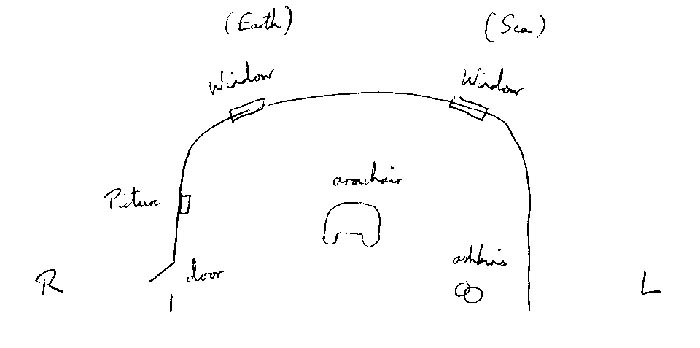Beckett, Endgame (1957)
CLOV What is there to keep me here?
HAMM The dialogue.
Postmodernism
[Following dispersal of power in globalism] Postmodern scholars argue that such a decentralized society inevitably creates responses/perceptions that are described as post-modern, such as the rejection of what are seen as the false, imposed unities of meta-narrative and hegemony; the breaking of traditional frames of genre, structure and stylistic unity; and the overthrowing of categories that are the result of logocentrism and other forms of artificially imposed order. Instead, they value the collage of elements, the play and juxtaposition of ideas from different contexts, and the deconstruction of symbols into the basic dynamics of power and place from which those symbols gain meaning as signifiers. In this it is related to post-structuralism in philosophy, minimalism in the arts and music, the emergence of pop, and the rise of mass media. (Wikipedia)
Stage set (Norton, 2662): diagram; said to represent interior of skull -- two eyes, etc.

Chess: "Endgame": Hamm, "Me to play" (2663, 2683, 2687)
Acting, Stagy: Hamm (as bad actor)
Hamm: "Can there by misery …": measuring suffering, cf. Lear (2663)
Hamm: I've made you suffer too much (2664)
Hamm: Forgive me (2666)
Clov: Things are livening up; sees audience (2671)
The dialogue (2680)
Hamm: An aside; underplot (2686)
Post-holocaust (Nevil Shute, On
the Beach 1957)
Setting: The shelter (2663; 2684)
There's nowhere else (2664)
Outside of here it's death (2665)
There's no more nature (2666)
Corpsed (2671)
Hamm: I once knew a madman (2676)
Windows: earth and sea (2682)
What's happened (2685)
Time
Grain upon grain… (2663; 2684) > i.e., moment after moment; atomizing of time
Something is taking its course (2666; 2672)
One day you'll be blind… Clov's future (2673)
Do you not think this has gone on long enough? (2676)
Hamm: time was never and time is over (2688)
Body: numerous references to -- smell, eating; Hamm must sit; Clov must stand
Language: Have you not had enough? -- meaning escapes (2664)
Rationality: all we have? -- but absurd: measuring (2670; 2678); infinity (2663)
Play ends as it began (2688); could be circular -- repeated ad infinitum
Postmodern? Final meaning? -- that it cannot be made to mean any single thing. According to Wilcher (1976), the play is a comment on "the inadequacy of approaching reality by trying to impose systems upon the minute-by-minute flux of sense impressions."
Chess. "Hamm is a king in this chess game lost from the start. From the start he knows he is making loud senseless moves. That he will make no progress at all with the gaff. Now at the last he makes a few senseless moves as only a bad player would. A good one would have given up long ago. He is only trying to delay the inevitable end. Each of his gestures is one of the last useless moves which puts off the end. He is a bad player." (Beckett, cited in Worton)
---- "It is because mankind is less than omniscient that Beckett wins his chess game against the audience; and it is because the play's characters are (ostensibly) mortal that they are fated to lose their game against death." (Acheson 189)
Acting. "Although Hamm appears to be proceeding rather self-consciously through the experience of dying, Beckett keeps the spectators of this play uncertain as to whether Hamm is dying or imitating the action of dying. Hamm performs himself in a theatrical presentation of himself for himself. Clov, Nagg and Nell provide the necessary audience and, at times, assume the roles that Hamm's performance demands." (Lyons 59)
Creation. "Beckett plays with the imagery of creation from Genesis, but he reverses the sequence. He begins with a world which divides light and darkness and separates land and water and moves toward obscure greyness and void." (Lyons 62-3)
Entropy. "Instead of following the tradition which demands that a play have an exposition, a climax and a denouement, Beckett's plays have a cyclical structure which might indeed be better described as a diminishing spiral. They present images of entropy in which the world and the people in it are slowly but inexorably running down." (Worton)
James Acheson, "Chess with the Audience: Samuel Beckett's Endgame." Critical Essays on Samuel Beckett, Ed. Patrick A. McCarthy. Boston: H. K. Hall. pp. 181-192.
Charles R. Lyons, Samuel Beckett. London: Macmillan, 1983.
Robert Wilcher, "'What's It Meant to Mean?' An Approach to Beckett's Theatre." Critical Quarterly 18 (1976): 21.
Michael Worton, "Waiting for Godot and Endgame: Theatre as Text."
Beckett resources online, see: Apmonia: A Site for Samuel Beckett